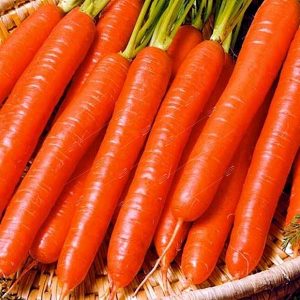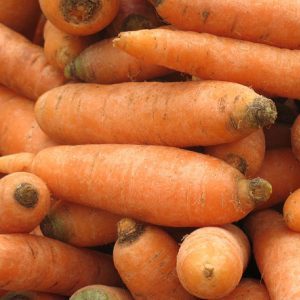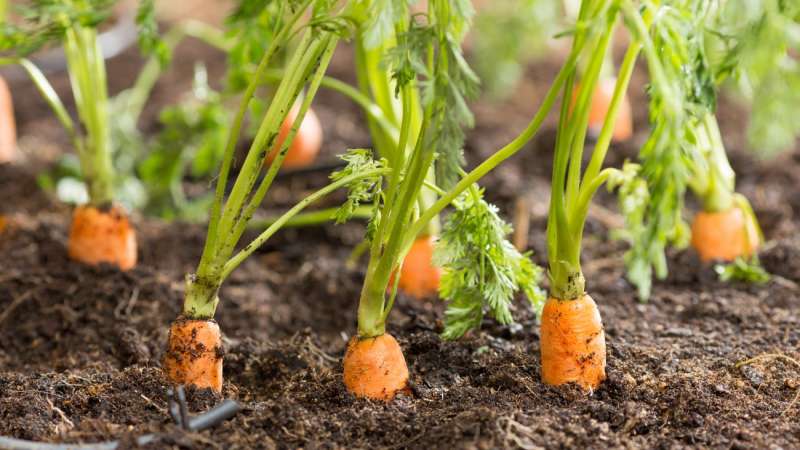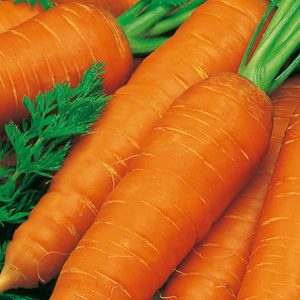Unpretentious variety of carrots Vitamin 6
Vitaminnaya 6 carrots, bred 50 years ago, are in stable demand among farmers. It is distinguished by unpretentious care, high yield rates, and good keeping quality. Gardeners appreciate it for its taste, the sweetness of root crops, and a high content of carotene.
The content of the article
Description of the variety of carrots Vitamin 6

Vitamin 6 carrots are mid-season varieties. The weight of one root crop is 100-170 g, sometimes specimens weighing 200 g are found. Root crops do not rise above the soil during growth, so their upper part does not turn green.
Vegetables tolerate long-term storage well.
Among other varieties of culture Vitamin 6 stands out for its sweet taste, high content of carotene and nutrients.
Origin and development
The variety was created in 1969 at the Research Institute of Vegetable Economy as a result of crossing the varieties Amsterdam, Nantes, Touchon.
The resulting variety is recommended for cultivation in almost all regions of the country.
Chemical composition, trace elements and vitamins, useful properties
100 g of carrots contain fructose - 17-22 mg, carotene - 7-10%.
There are 23.5 kcal per 100 g of the product. The benefits of carrots are in the content of vitamins, macro- and microelements.
Macronutrients:
- potassium - 207 mg;
- calcium - 24.7 mg;
- phosphorus - 46 mg;
- magnesium - 35.3 mg;
- sodium - 17.2 mg;
- sulfur - 4.4 mg.
Trace elements:
- iron - 0.8 mg;
- zinc - 0.3 mg;
- aluminum - 0.21 mg;
- manganese - 0.23 mg;
- boron - 0.24 mg;
- copper - 0.7 mg;
- fluorine - 0.5 mg.
Vitamins:
- A - 0.94 mg;
- B1 - 0.07 mg;
- B2 - 0.05 mg;
- B9 - 0.12 mg;
- C - 0.48 mg;
- PP - 1.2 mg;
- E - 0.77 mg.
Carrots have a beneficial effect on vision, prevents intestinal dysbiosis, prevents vascular diseases, improves the functioning of the gastrointestinal tract, prevents the formation of stones in the gallbladder and kidneys.
Application features
Vitamin 6 carrots - universal variety: used for conservation, frost, storage for the winter... The variety is recommended for eating raw, making juices for children, vegetable purees.
Ripening period
Vitamin 6 belongs to mid-season varieties. The growing season is 75-100 days.
Yield
The variety has high yields. Subject to the conditions of agricultural technology, they collect 3.6-7.7 kg from each m² of land.
Disease resistance
The variety is prone to typical crop diseases and pest attacks... For prevention, soil and seeds are disinfected before sowing.
Characteristics, description of appearance, taste

Semi-standing rosette, forms 8-12 dissected bright green leaves. The fruits are oblong, even, cylindrical in shape with a rounded tip. The color of carrots is red-orange, the core is thin, in the form of an asterisk. Fruit length 18-20 cm, weight 100-170 g.
The variety has excellent taste, the pulp is juicy, crunchy, sweet.
For which regions it is best suited and what is the exacting climate
Suitable for growing in all regions of Russia, except for the North Caucasus. It develops successfully in adverse conditions.
The main advantages and disadvantages of the variety
This variety has many benefits:
- unpretentiousness to climatic conditions;
- high yield rates;
- good keeping quality;
- resistance to shooting;
- excellent taste;
- high content of fructose and beta-carotene.
Disadvantages of the variety:
- low resistance to disease;
- there is a small percentage of fruit cracking;
- for sowing, fresh seeds are required, since seed material loses germination after two years.
What is the difference from other varieties
Vitamin 6 differs from other varieties:
- resistance to shooting and color;
- the variety tolerates dry weather and frost well;
- fruits contain about 22 mg of beta-carotene, which exceeds the content of the compound in other varieties.
Features of planting and growing
Since the variety tolerates frost well, farmers advise to plant seeds immediately after the snow melts, when the soil warms up to + 8 ° C, to get an early harvest. Before planting, the soil is enriched with organic matter: compost, rotted manure, wood ash.
Preparing for landing
Carrot seeds Vitamin 6 are produced on tape and in granules... It is more convenient to plant such seeds, since less attention is paid to thinning. But to dissolve the granules, increased watering is required.
If you use self-harvested seeds, you need to prepare them. Seeds are sorted out, damaged seeds are discarded. The selected ones are soaked in water for 1-1.5 hours. High-quality seeds will sink to the bottom of the container, empty ones will float to the surface.
Selected seeds are disinfected in a pink solution of potassium permanganate or a solution of "Fitosporin-M" for 50-60 minutes. Then the seeds are germinated in a damp cloth for 5-7 days. Germinated seeds are sprayed with a growth stimulator "Epin" (4 drops per 1 liter of water) before planting.
Ground requirements
Mineral and peat soils are most favorable for cultivating the variety. The acidity should be neutral. Carrots good is growing on drained, loose, light soils. The site is prepared in the fall, digging it up with organic and mineral fertilizers.
Predecessors
Compliance with the rules of crop rotation directly affects the yield of the variety. The culture is not planted after legumes, parsley, dill, fennel.
Important! The best precursor to carrots is potatoes.
Timing, scheme and landing rules
Planting seeds in open ground is carried out in late April - early May, when the soil warms up to + 7 ... + 8 ° С. In a previously prepared area, grooves are made with a depth of 2 cm. A distance of 18-20 cm is left between the rows. Before laying the seeds, the grooves are watered with warm water. Seeds are placed with an interval of 2 cm. The grooves are sprinkled with earth, lightly tamped.
Growing features

For the convenience of sowing seeds, some gardeners mix them with clean sand in equal proportions. Emerging seedlings are easier to thin out.
In order not to wash the seeds out of the soil, drip irrigation is carried out at first.
The nuances of care
The soil in the beds should be well dug. In heavy soil, carrots deform. It is recommended to loosen the soil regularly, since the soil crust negatively affects the taste of carrots.
Watering mode
The emerging seedlings are watered 2 times a week. In dry times, in the absence of precipitation, watering is carried out 3-4 times a week. It is recommended to water the culture in the morning. As the plants grow, the frequency of watering is reduced to once a week, while the volume of liquid is increased.
Attention! The soil is moistened to a depth equal to the length of the root crops, on average 18-22 cm.
It is recommended to stop watering 2-3 weeks before harvesting.
Thinning and weed control
As the seedlings grow, thinning is carried out. The first time is when two pairs of leaves grow on the seedlings. Weak specimens are removed, increasing the distance between the remaining shoots.
The second time, the carrots are thinned out during the formation of root crops, leaving a distance of 3-4 cm between the plants.
As the culture grows and the plantings thicken, the third thinning is carried out, removing less developed plants.
Attention! The distance between adult plants should be at least 6-7 cm.
During thinning, weeds are simultaneously weeded. Weed grass grows faster than carrot shoots, taking nutrients from the soil, so weeding is mandatory.
Top dressing
At the beginning of the growing season, fertilizing with urea is carried out, for this 20 g of the drug is diluted in 10 liters of water.
The second feeding is carried out after 20-25 days, during the formation of fruits. Potassium and phosphorus are introduced in the following composition: 20 g of potassium nitrate, 20-25 g of superphosphate per 10 liters of water.
The third feeding is done in July, 3 weeks after the second. At this time, the roots begin to fill with juice, so they need boron and manganese. The beds are watered with the composition: 2 g of potassium permanganate, 4 g of boric acid are diluted in 10 liters of water.
During the entire growing season, organic matter is used: 200 g of wood ash is poured into 10 liters of water, insisted for 2-3 days, watered at the root.
Important! Nitrogen fertilizers are used only at the beginning of the growing season.
In total, 3-4 dressings are carried out per season.
Disease and pest control
The most common diseases of the Vitamin 6 variety:
- Fomoz (dry rot) is a fungal disease that affects carrots during the growing season and storage of fruits. Gray-brown elongated spots are formed on the tops. Gradually, the disease spreads to root crops, causing them to rot. At the first sign, an aqueous solution of the drug "Maxim" (1: 1) is used. For prevention, phosphorus-potassium fertilizers are applied to the soil.
- Rhizoctonia - "felt disease", manifests itself in the form of lead spots on the fruits, which cause rotting. Affected bushes are watered with a solution of copper sulfate. To prevent disease, liming of the soil is carried out before planting.
- Bacteriosis - wet bacterial rot. The disease begins on the lower leaves in the form of yellow spots that grow and darken. Then the stems are covered with dark brown spots. Wet areas of a dark color appear on root crops, an unpleasant smell of rot appears. In order to prevent the disease, seedlings are sprayed with the preparation "HOM" at the rate of 30-35 g of substance per 10 liters of water.
Common pests of the variety:
- Carrot lily - feeds on leaves, causing them to "curl". The bush grows slowly, the roots become bitter. For the fight use insecticides "Borey", "Vantex", "Alatar".
- Slugs actively feed on tops and eat out large areas on the base of root crops. For prevention and control, crushed egg shells are scattered around the plants - the naked body of a slug cannot stand scratching objects. In the evening, the plants are sprayed with a salt solution: 100 g of salt per 10 liters of water.
Harvesting and storage
Carrots planted in April reach full maturity in August. Cleaning is carried out in dry weather. The collected roots are dried, sorted and placed in winter storage.
How and when to collect

The degree of ripeness of carrots is judged by the state of the tops. When the lower leaves on the stem turn yellow, harvest begins.
Carrots are harvested by hand by pulling the tops. If it is difficult to extract the fruit, use a pitchfork. The vegetables are shaken off the ground, the leaves are cut or rolled.
Then the roots are sorted: vegetables with mechanical damage are selected for processing, the whole ones are laid out in one layer in a dry ventilated room to dry. After a week, the vegetables are transferred to the vegetable store.
Storage features and keeping quality of the variety
For long-term storage, conditions are created with an air temperature of + 2 ... + 4 ° C, humidity in the storage in the range of 85-90%.There must be constant air circulation in the room. Under proper conditions, keeping quality of carrots reaches 98%.
What can be the difficulties in growing
With uneven and excessive watering, cracking of root crops is observed.
With an excess of ash and nitrogen in the soil, carrots become multi-tailed.
With too much watering, many hairs appear on the fruits - adjust the volume of the applied liquid.
Tips from experienced gardeners
Experienced gardeners advise planting the variety as early as possible so that the moisture from the melted snow does not have time to evaporate. But at the same time, the soil should warm up to + 8 ° C.
Gardeners recommend regular watering. Irregular watering leads to cracking of root crops.
Experienced gardeners advise to stop feeding and watering 25-30 days before harvesting.
Reviews of the variety of carrots Vitamin 6
The opinions of many consumers about the taste and marketability of carrots coincide.
Olga, Tula: «For several years I have been growing the variety Vitamin 6. The variety is easy to care for. The fruits grow 14-17 cm. They are very tasty and sweet. "
Elena, Saratov: “I tried to grow Vitamin 6 carrots. There were no problems with growing. The kids loved the sweet taste of the carrots. Everybody liked the freshly squeezed juice too ”.
Igor, Perm: “A neighbor shared the seeds of Vitamin 6. I planted the seeds in May, all sprouted. Harvested in August. Root crops are even, not cracked. The pulp is juicy, sweet. I was pleased with the variety. "
Conclusion
Carrot variety Vitaminnaya 6 is unpretentious, develops successfully and gives a good harvest in almost all regions of Russia. The variety tolerates light frosts and drought well. Excellent taste attracts farmers. The large amount of vitamins in root vegetables makes them healthy.